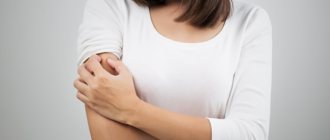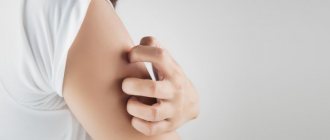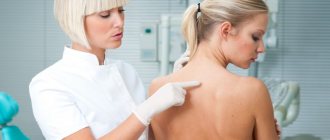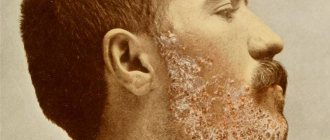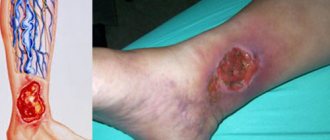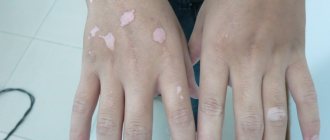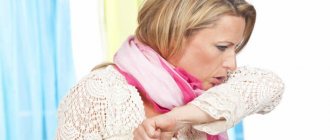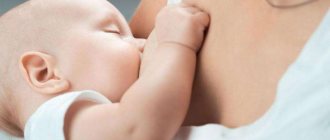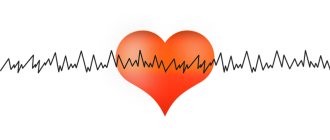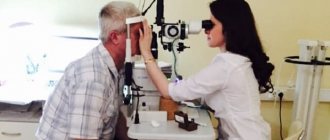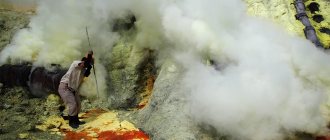The essence of the disease
Seborrhea is an inflammation of the skin in the area where the sebaceous glands are located. With increased secretion of the sebaceous glands, a sebaceous consistency is released through the pores, which creates favorable conditions for the development of microbes.
Seborrheic irritations are localized:
- in the thoracic region;
- on the back between the shoulder blades;
- on the forehead, nose, chin, cheeks;
- on the head under the hair:
- in the area of the ears.
The disease worsens in the off-season, making itself felt especially actively in spring and autumn. In most cases it is a chronic form.
Seborrhea does not belong to the simplest dermatoses; the lack of proper treatment can be as follows:
- baldness of the affected areas of the skin (scalp);
- development of ear diseases (otitis media);
- decreased vision and inflammation of the eyes (conjunctivitis);
- the appearance of persistent dandruff in the hair;
- development of furunculosis.
Seborrheic dermatitis is a type of non-contagious lichen.
Sulsena paste 2% and shampoo
Sulsen paste and shampoo based on selenium disulfide effectively cope with dandruff, normalizing the activity of the sebaceous glands and the processes of skin self-renewal.
The ointment contains glycerin, sodium cetearate sulfate, potassium cetearate, phosphate, cetyl, stearyl and brown alcohol and the main active ingredient is selenium disulfide in 1% or 2% concentration.
To treat dandruff, Sulsena paste 2% is used twice a week for three months. Sulsena paste with 1% selenium is used to prevent dandruff once a week, and a 2% concentration is used less frequently - once a month to treat the scalp.
A course of using Sulsen paste allows you to strengthen hair, normalize skin condition and remove dandruff in six months.
Side effects of Sulsen products include irritation and allergic reactions in persons with sensitivity to one of the components of the product; hair color may change or hair may fall out in small quantities. Sulsen paste should not be used by people prone to allergies and pregnant women.
How to use Sulsena paste:
- Carefully wash your hair with shampoo, you can use shampoo from the Sulsen line;
- Apply the paste to the damp scalp and massage it in with your fingers, trying to avoid getting it into the eyes;
- After ten minutes, rinse with clean water.
Other auxiliary products are Sulsena shampoo, which can be used during treatment instead of regular shampoo, Stimulin oil and cream against hair loss, which enhances nutrition of the hair follicles.
Pathogens
Today, experts know that the causative agents of seborrhea are identified as yeast-like fungi of the Pityrosporum ovale family:
- Malassezia restricta;
- Malassezia globosa.
They live on the skin of almost all people. But these fungal infections can multiply quickly only in a rich, sebaceous environment. Increased or decreased production of sebaceous secretions is observed in the absence or weakening of the body's immune defense.
Signs of seborrhea
Seborrheic eczema is recognized by symptoms such as:
- small rash;
- skin redness;
- the formation of large inflamed areas with clearly visible peeling scales;
- burning and itching;
- presence of dandruff in hair;
- the appearance of papules and blisters on the skin;
- hair loss.
If a secondary infection is added to seborrheic eczema, ulcers and ulcers form on the inflamed areas of the skin.
Sulfuric ointment
Sulfur has a powerful antiseptic and antiparasitic effect, which allows you to successfully treat dandruff and seborrhea caused by pathogenic fungi. Sulfur ointment, which is prepared in the prescription departments of pharmacies, also contains excipients - petroleum jelly and animal fats. Used to treat dermatological diseases, seborrhea, psoriasis and scabies caused by parasites.
Apply sulfur ointment externally - rub into the scalp and leave for five minutes to act, after which it is washed off. The sulfur concentration in the ointment is 10%, which can cause irritation on sensitive and delicate skin, so it is not used to treat children.
The course of treatment is a week, at the end of this period they take a break of one day. Further treatment of seborrhea is carried out using medicinal hair cosmetics, which contain sulfur in lower concentrations.
Recommendations for the treatment of seborrhea with sulfur ointment^
- Sulfur is a potent ingredient in the product that can cause an allergic reaction in sensitive people.
- There are contraindications for treating pregnant women and children with sulfur ointment.
- Since the effectiveness of sulfur ointment is based on its antifungal effect, before using it it is recommended to determine the type of fungus causing it; sulfur will not have an effect on some of them.
- For thin and dry hair, it is better to refrain from using sulfur ointment, as its components can aggravate the condition of the hair. Before use, you need to try more gentle methods of treating seborrhea.
- Possible side effects include local burning, swelling at the application site, redness of the skin, burning and pain.
An alternative to sulfur ointment in the treatment of seborrhea can be other medications containing sulfur - sulfur-salicylic or sulfur-tar ointment.
Provoking factors
Experts include the following among the main root causes causing the proliferation of fungal infections on human skin:
- heredity;
- diseases of the endocrine system;
- HIV infection, AIDS;
- epilepsy;
- hypothermia;
- excessive work of sweat glands;
- nervous disorders and stress;
- unbalanced diet;
- interseasonal vitamin deficiency;
- incorrect approach to choosing alkaline detergents;
- bad habits (smoking, alcohol);
- diseases of the gastrointestinal tract;
- brain diseases;
- disorders in the immune system.
The above reasons can negatively affect skin health, both individually and collectively. Their effective elimination has a positive effect on the process of inhibiting the development of fungal infections.
Types of seborrhea
Seborrhea disease is complicated not only because in most cases it goes into a chronic stage, but also because there are a large number of subtypes that differ in external signs and symptoms and have similar characteristics of the course.
Seborrheic eczema can be:
- congenital – genetic predisposition makes itself felt;
- acquired – caused by diseases of internal organs.
Seborrhea is also classified into:
- adult – provoked by age-related changes in the body;
- children's - manifested from the first days of life.
According to the severity of the signs of the disease, seborrhea is divided into:
- seborrheic eczematide is a mild form of the disease, which is characterized by minor inflammation and peeling of the skin;
- spotted seborrheic eczema - occurs with complications, tends to acquire a chronic form, is difficult to cure, and is characterized by constant relapses.
The principle of dandruff
Human skin performs a protective barrier function.
The first to suffer from the negative influences of the external environment is the epidermis, which consists mostly of the stratum corneum and has a complex structure. The stratum corneum has a unique structure, which is called brick and mortar (“cement and brick”), the role of “bricks” is given to horny cells, and intercellular lipids act as “cement”.
https://www.youtube.com/watch?v=fDSqKJCakCg
Thanks to a natural process, involuntary rejection of horn cells occurs from the skin surface every day. When changing items of clothing and while walking, hundreds of thousands of scales form around a person.
So, in one minute there are up to 20 thousand scales around a person. Over the course of a year, over 100 grams of scales are rejected from every square meter.
If the stratum corneum is damaged and the integrity of the skin barrier is compromised due to the action of internal and external factors, then an adaptive reaction appears, which manifests itself in the form of accelerated separation and an increase in the volume of stratum corneum cells.
In the normal cell development cycle, basal keratinocytes from the lower layer of the epidermis reach the stratum corneum in 25–30 days. During this period, keratinocytes dry out and become keratinized.
In the case of an accelerated process within 5-14 days, individual cells that have not had time to lose water stick together and peel off like yellow-white flakes or scales, called dandruff. It is the first sign of seborrhea.
Seborrhea in adults, types
In adulthood, people are characterized by hormonal imbalances, deviations from proper nutrition, physical fatigue and frequent nervous tension, and infectious diseases. Against this background, various types of seborrheic eczema arise:
- oily – characterized by dilation of the sebaceous glands, increased secretion of sebaceous substance, which is dominated by higher fatty acids, which reduce the skin’s ability to resist infections and bacteria, which in turn is fraught with the formation of ulcers;
- dry - characterized by the opposite effect of the sebaceous glands - insufficient secretion of sebum, which leads to dryness of the skin and its cracking, resulting in inflamed microwounds with the formation of flaking scales;
- mixed - represents selective areas of the skin in the area of which the sebaceous glands produce either little or a lot of sebaceous secretion.
Oily seborrheic eczema
Oily seborrhea is typical for adolescence. It is more often observed in girls under 16 years of age and in boys under 20 years of age. It also appears in adult men. Oily seborrheic eczema is divided into two types:
- Liquid, which is characterized by the formation of clearly visible open pores on the skin, due to which it becomes like an orange peel, shiny, rough, sebum and dirt accumulate in the open pores; dermatologists call this phenomenon comedones.
- Thick, which is characterized by the formation of pores clogged with yellow sebaceous thick secretions, called closed comedones.
When oily seborrheic dermatitis appears on the head, there is gluing of hair strands, accumulation of oily sheen on them, abundant dandruff, a gray tint on the face, oily sheen of the skin, redness, and the formation of profuse acne.
Dry seborrhea
Dry seborrheic eczema manifests itself in children before the maturation of the reproductive system; cases of the disease developing in adults cannot be excluded.
- With the development of dry seborrhea on the head, skin modifications such as keratinization, abundant flaking of scales, and the formation of white or yellow crusts are observed. The hair follicles weaken, causing the hair to become thin, brittle and fall out, forming visible areas of baldness on the scalp.
- When dry seborrhea occurs, pink spots appear on the face, which gradually acquire a more pronounced shade, close to red. Black acne forms in the area of inflamed areas of the skin. After washing, the skin becomes tight and itchy.
Sebum: why?
There is nothing superfluous in the human body, but everything functions as intended by nature itself. The skin contains pores through which sweat can be released to protect the body from overheating, as well as fat, which is necessary to maintain the fat and water balance of the skin. If there is no fat or there is little of it, the epidermis begins to dry out and becomes susceptible to various infections. Excess sebum also contributes to dysfunction. Seborrhea of the scalp occurs on the scalp, neck and shoulders, and face.
Seborrhea in children, types
Seborrheic eczema in children appears immediately after birth, as well as a year or two later.
Depending on the time of diagnosis of the disease, experts classify it into:
- seborrhea of infants;
- seborrhea in children older than one year.
Seborrhea of infants
Seborrhea in infants has three degrees of severity:
- mild - a slight scaly rash covers the head, skin behind the ears, cheeks, forehead, but the baby’s health is normal;
- moderate - rashes are observed on the arms and legs and throughout the body, while the baby is capricious, suffers from diarrhea and frequent regurgitation, and refuses to eat;
- severe – there is severe diarrhea, lack of appetite, swelling of the rash throughout the body, fever, weight loss.
Seborrhea in infancy causes great discomfort to the child - itching, pain, disruption of moisture exchange processes in the skin, release of exudate that disrupts the blood circulation in the area of inflamed areas of the skin, promoting the accumulation of toxins, which leads to diseases of the nervous system and internal organs of the baby.
Seborrhea in children older than one year
Seborrheic eczema in children over one year of age has similar symptoms to the adult form of the disease. In childhood, seborrhea on the skin of the body is a consequence of unformed immunity, anxiety, stressful situations, exacerbations of other chronic ailments, infection, and non-compliance with healthy eating rules.
Experts distinguish between liquid and thick forms of childhood seborrhea, which manifests itself in the same areas of the body as in adults.
Therapeutic therapy of seborrhea, disease prevention
The fight against seborrhea requires an integrated approach. The first step to recovery is contacting a dermatologist, gastroenterologist, endocrinologist, gynecologist, neurologist, or psychiatrist. Completing a comprehensive examination of the patient’s body allows us to detect the root cause that provokes the development of the disease and eliminate it with the help of effective therapeutic measures.
Along with therapeutic measures, the patient is prescribed the following preventive procedures:
- complete peace;
- compliance with the work and rest regime;
- a diet that excludes the consumption of alcoholic beverages, carbohydrate, fatty, savory, fried, sweet foods; the diet should be rich in fresh vegetables and fruits, boiled or steamed foods;
- physiotherapeutic procedures - massage, magnetic therapy, laser treatment of the skin;
- the correct choice of personal hygiene products for body skin and hair care;
- wearing clothes made from natural fabrics;
- frequent change of wardrobe items, bedding and hygiene items.
Treatment methods for seborrheic eczema in adults
Treatment of seborrheic dermatitis of the skin can be carried out according to various prescriptions. The list of therapeutic prescriptions depends on the complexity of the disease. The main goal in each specific case is to normalize nutrition with the necessary substances and ensure complete moisture exchange of the skin, which helps relieve inflammation, heal ulcers, soften the skin and narrow pores.
Drug therapy
Medical prescriptions for seborrheic dermatitis are limited to the prescription of tablets and topical preparations.
Effective oral medications for the treatment of seborrheic dermatitis include:
- "Doxycycline" is an antibacterial drug;
- “Citrine”, “Diazolin”, “Loratadine” - antihistamines;
- “Multitabs”, “Merz”, “Perfectil” - vitamin pills.
Commonly used external medications for seborrhea:
- immunostimulants "Protopic", "Tacolimus";
- hormonal ointment "Elocom";
- antifungal creamy ointments and gels “Lamisil”, “Mikospor”, “Ketodine”, “Miconazole”.
Medical cosmetology
For seborrhea, the skin care regimen is reviewed. Cannot be used in everyday life:
- aggressive means for washing and wiping the skin;
- tonics, lotions containing an alcohol component.
Facial care
When it comes to seborrhea on the face, it is recommended to give preference to creams and milks that contain antimicrobial, anti-inflammatory and antifungal substances, such as zinc, ketoconazole, selenium, birch tar, celandine juice, St. John's wort, string, vitamin B5, tea tree oil . Facial cosmetics are applied in courses.
Hair care
If you mean the treatment of seborrhea on the head, then you should use shampoos for hair care, which include:
- selenium sulfide, ketoconalosis – inhibit fungus;
- medical tar, zinc pyrithione, ciclopirox - relieve inflammation, slow down the proliferation of fungi and prevent peeling of the skin.
Shampoos should be chosen without containing aromatic fragrances, parabens, aggressive components SLESS and SLS.
Apple cider vinegar 6% for dandruff
Organic acids in apple cider vinegar have a cleansing effect on the skin and help prevent dandruff. The use of apple cider vinegar during hygiene procedures helps to normalize the acid-base balance of the scalp, remove the fungus that causes seborrhea, and make hair healthier and stronger.
In addition to its cleansing, toning and restorative effect on the skin, apple cider vinegar is beneficial for hair as it has a conditioning effect. After vinegar rinsing, keratin scales close, tightly adjacent to each other, making the hair more shiny in appearance and easier to comb.
Beneficial properties of apple cider vinegar:
- The composition is rich in vitamins B, C and A, as well as minerals, organic acids and pectin, which enriches skin cells and enhances nutrition of hair follicles;
- Neutralizes free radicals, gently exfoliates dead cells, has a regenerating effect on the skin, accelerates the healing of microscratches and cleanses it of toxins and dust contaminants;
- It has a tonic and refreshing effect, destroys pathogenic microorganisms.
You can find apple cider vinegar in concentrations ranging from 4 to 6% on sale; you can buy it at a pharmacy or in grocery stores. Natural apple cider vinegar has a characteristic apple aroma and a brown-golden hue.
How to use apple cider vinegar to treat dandruff:
- Apple cider vinegar rinse. Add four tablespoons of apple cider vinegar to a glass of boiled water cooled to room temperature and wash your hair from roots to ends. After the procedure, rinse again with clean water.
- Anti-dandruff mask with apple cider vinegar. A 6% vinegar solution is an effective remedy against dandruff. It is applied to the scalp in its pure form and left for fifteen minutes. After this, wash your hair, dry your hair naturally and comb it.
- Revitalizing mask with apple cider vinegar - this product is used to treat the scalp. In addition to vinegar, such a mask can include other medicinal components - medicinal herbs (chamomile gives a calming and anti-inflammatory effect, mint has a tonic effect). To prepare the mask, take a glass of boiled water, 2 tablespoons of vinegar and decoctions of medicinal herbs. The warm mixture is applied to the hair roots and along their entire length, after which they are wrapped in polyethylene and put on a warming cap or heated with a hairdryer for 2-3 minutes. The mask is kept for 30 minutes, after which it is washed off with clean water. The course of treatment for seborrhea with masks is two months, 1-2 times a week.
We suggest you familiarize yourself with: Speckled head of penis
Treatment methods for seborrhea in children
Therapeutic therapy for seborrhea in children of the first year of life consists of performing the following procedures:
- taking baths with the addition of chamomile, burdock, calendula, sage, dandelion;
- treating the baby's skin with olive oil;
- applying antifungal, anti-inflammatory gels and ointments to the skin;
- taking immunostimulants, vitamins, hormonal drugs,
- diet by the mother if the child is breastfed.
In children over one year of age, therapy aimed at combating seborrhea is reduced to the same measures as in the treatment of infants, and is supplemented by taking antihistamines, antibiotics and physiotherapeutic procedures.
